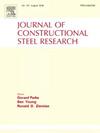Study on factors affecting the resonance fracture location in e-type fastener clips
IF 4
2区 工程技术
Q1 CONSTRUCTION & BUILDING TECHNOLOGY
引用次数: 0
Abstract
In this study, the natural frequencies and influencing factors of the e-type fastener clips were first analyzed through modal simulation and hammer impact test, and combined with the vibration frequency caused by rail corrugation, the modal resonance order was determined. Then, the stress field of the e-type fastener clips under inertial loads from each resonant mode was simulated, exploring the impact of the increasing proportion of inertial loads in different directions on fracture locations. Finally, a fatigue testing method employing equivalent preloading of resonant inertial loads was applied to reproduce fracture locations under various resonant modes. The results show that the friction coefficient between the clip's toe and the gauge block significantly impacts the 2nd-order natural frequency of the e-type fastener clips, which is associated with its modal lateral vibration. When the friction coefficient drops to about 0.1, on the distal side where the gauge block moves toward the iron plate support, this frequency of the e-type clips decreases by 363.2 Hz compared to conditions without trainload, causing simultaneous 1st-order and 2nd-order modal resonance. If the growth ratio of vertical inertial loads exceeds that of lateral loads, fractures occur at the arch heel; conversely, fractures occur at the front arch.
影响 e 型紧固件夹共振断裂位置的因素研究
本文章由计算机程序翻译,如有差异,请以英文原文为准。
求助全文
约1分钟内获得全文
求助全文
来源期刊

Journal of Constructional Steel Research
工程技术-工程:土木
CiteScore
7.90
自引率
19.50%
发文量
550
审稿时长
46 days
期刊介绍:
The Journal of Constructional Steel Research provides an international forum for the presentation and discussion of the latest developments in structural steel research and their applications. It is aimed not only at researchers but also at those likely to be most affected by research results, i.e. designers and fabricators. Original papers of a high standard dealing with all aspects of steel research including theoretical and experimental research on elements, assemblages, connection and material properties are considered for publication.
 求助内容:
求助内容: 应助结果提醒方式:
应助结果提醒方式:


